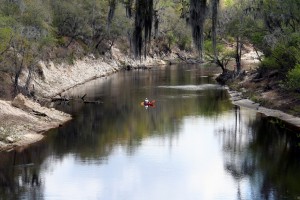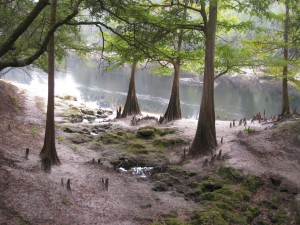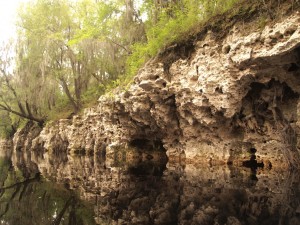The Suwannee River is perhaps the most well-known river in the state of Florida, inspiring songs and legends of life along its banks. The river stretches over 235 miles in length on its journey from the Okefenokee Swamp in Georgia to the the Gulf of Mexico near Cedar Key, Florida. The river has a rich history and diverse ecosystem including over 62 freshwater springs, making it a prime destination for paddlers.
The Suwannee River has received federal recognition as a wild river and is part of the Florida Greenways & Trails Program, promoting it as a paddling trail for kayakers and canoeists. The Suwannee’s unique features also create the only two sections of whitewater on the river at Little Shoals and Big Shoals (Class III) upstream from the town of White Springs.
A Brief History of the Suwannee River
Timucuan, Apalachee and Seminole Indian tribes all inhabited the banks of the Suwannee before Spanish explorers arrived in the area in 1530. There is much speculation over which tribe deserves the credit for giving the Suwannee its name; the Creek and Cherokee have even been rumored to have had a hand in the naming of this historic river. As a result definitions of the Suwannee, or Suwanee as it is sometimes spelled, range from “Echo River” and “River of Reeds” to “Deep Water,” and “Crooked Black Water.”
During the Civil War the river played an important part by allowing steam boats to transport soldiers, equipment and supplies to the Confederate forces. The steamboat Madison even captured a Union gunboat on the river. Later the Madison went on to transport food to starving troops under the condition that she be scuttled afterward so as not to fall into enemy hands. The remains of the sunken Madison can still be seen at the bottom of Troy Springs near Branford.
Perhaps the most famous tribute to the Suwannee was in the very first line of Stephen Fosters song, “Old Folks at Home.” After struggling to find an opening line for a nearly completed piece, Stephen Foster chose and unintentionally misspelled, “Way down upon de Swanee Ribber.” The song went on to become the Official Song of the State of Florida.
Paddling the Suwannee River
A float trip on the epic Suwannee River is best accomplished through careful planning. Paddlers may want to break the lengthy trip down into several multi-day trips or over a period of two to three weeks as they paddle from point to point. Campsites are strategically spaced out in 9-17 mile increments making planning a trip much easier and avoiding inadvertently trespassing on private lands in the process. There are also a total of 12 state parks along the river, seven of which offer camping.
The Suwannee is broken down into three sections: the upper Suwannee at White Springs, Fla; the middle Suwannee at Suwannee River State Park at Ellaville; and the lower Suwannee which begins at Branford and continues on to the town of Suwannee located about 15 miles northwest of Cedar Key, Fla. It is advisable to check with local outfitters before beginning a trip to garner local river conditions. The upper Suwannee can be difficult to navigate at both low and high water levels.
Paddlers will glide past high limestone ledges, outcroppings and shoals in the upper section of the river before it broadens and slows in the middle section revealing sandy banks. The lower section showcases creeks, sloughs and salt marsh as it nears the mouth of the river.
Maps and detailed planning information for the 170-mile Florida paddling trail can be found on the Suwannee River Wilderness Trail website, a joint venture sponsored by the Florida Department of Environmental Protection, the Suwannee River Water Management District and Florida State Parks. Additional camping information for many of the state parks and other campsites is also available.
Additional Resources
[amazon_enhanced asin=”1561644498″ /]
This article is copyrighted by Beverly Hill




I wanted to do about half of this trip two years ago but injured my back. The cool thing about this trip is the campsites along the way, most of which are free!!